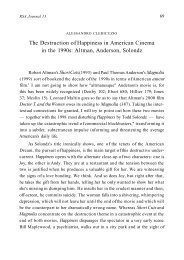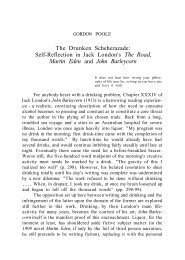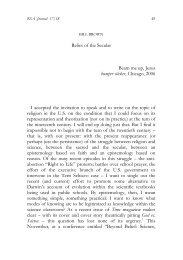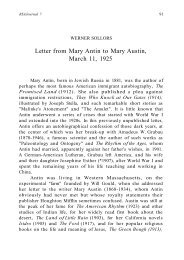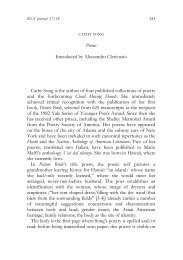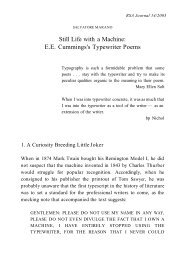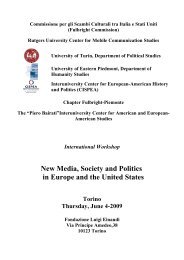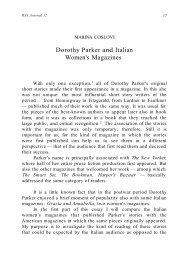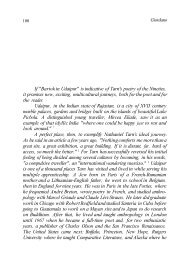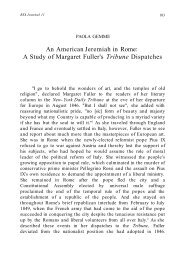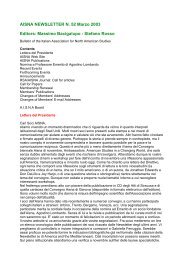Myth and Carnival in Robert Coover's The Public Burning - aisna
Myth and Carnival in Robert Coover's The Public Burning - aisna
Myth and Carnival in Robert Coover's The Public Burning - aisna
- No tags were found...
You also want an ePaper? Increase the reach of your titles
YUMPU automatically turns print PDFs into web optimized ePapers that Google loves.
14 Da<strong>in</strong>ottoCope's suggestion further, I would argue that <strong>Coover's</strong> dialogismfunctions as much more than a carnival—i.e., as the carnivalization of apublic event which was not supposed to be a carnival.It might be useful here to dist<strong>in</strong>guish between the ritual tension<strong>and</strong> the carnivalesque tension <strong>in</strong> <strong>The</strong> <strong>Public</strong> Burn<strong>in</strong>g. On the one h<strong>and</strong>,we have Uncle Sam's monologic desire to assert his drama as "true"<strong>and</strong> absolute, us<strong>in</strong>g the Rosenbergs's execution as a ritual for therenewal of America's s<strong>in</strong>k<strong>in</strong>g spirit, to "make everyth<strong>in</strong>g new aga<strong>in</strong>:after all, that was what light <strong>and</strong> darkness, the sacred <strong>and</strong> the diabolic,death <strong>and</strong> regeneration were all about!" (PB 95); on the other h<strong>and</strong>, wewitness the fall<strong>in</strong>g apart of Uncle Sam's metaphoric structures. <strong>The</strong>untenability of the"gr<strong>and</strong> narrative" of his dossier on the Rosenbergs,which "grew <strong>and</strong> grew [l]ike P<strong>in</strong>occhio's nose" (PB 368), transforms thecelebration <strong>in</strong>to a farce <strong>in</strong> which the "whole nation is fall<strong>in</strong>g on its ass"(PB 363). As Coover sets fiction (dialogism) aga<strong>in</strong>st myth (monologism),<strong>in</strong> exactly the same way the narrator of <strong>The</strong> <strong>Public</strong> Burn<strong>in</strong>g setsthe carnival aga<strong>in</strong>st Uncle Sam's official mythologiz<strong>in</strong>g effort. As forFoucault's model, <strong>Coover's</strong> theater of the public burn<strong>in</strong>g can flip fromdiscipl<strong>in</strong>e <strong>in</strong>to its opposite number when the sovereign's rhetoric isdenounced, its <strong>in</strong>tention reversed, <strong>and</strong> "public execution allow[s] theluxury of... momentary saturnalia" (Foucault 60).<strong>Coover's</strong> exemplary narrative is rooted <strong>in</strong> his twofold way of<strong>in</strong>terpret<strong>in</strong>g the Rosenbergs's execution as official ritual (myth) or assubversive carnival (fiction), <strong>and</strong> <strong>in</strong> the dialogic tension therebycreated. It is, from a different perspective, an ecology of the public"place"—the literary topos of Times Square. What, he seems to beask<strong>in</strong>g, are the uses of a public place such as the novel form or the citysquare? Should we use it for mythologiz<strong>in</strong>g purposes <strong>and</strong> there<strong>in</strong> stagethe theater of power, or should we use it to enact the drama of aliberat<strong>in</strong>g carnival? When Nixon tells us that Times Square "is themost paradoxical place <strong>in</strong> all America" (PB 164), we are ready toregister Times Square as an allegory (etymologically: allos-agora, placeof assembly) of fiction <strong>in</strong> general, that "vibrant space between the polesof paradox where all the excit<strong>in</strong>g art happens" (Coover 1983, 67). Asparadoxical space, Times Square, that allegory of fiction, oscillatesbetween the two poles of ritual <strong>and</strong> carnival, myth <strong>and</strong> de-mythification,order <strong>and</strong> subversion, Law <strong>and</strong> saturnalia, the novel as



